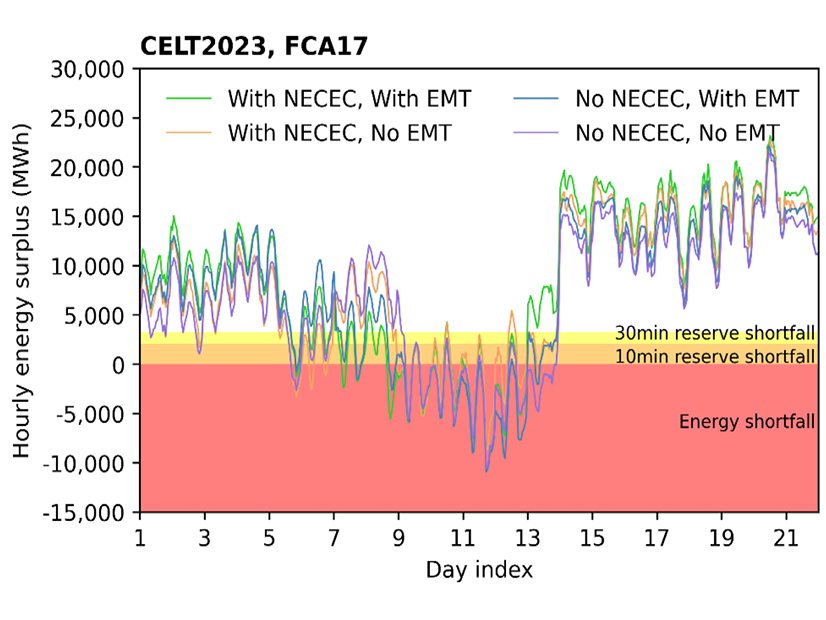ISO-NE presented the final stage of its Operational Impact of Extreme Weather Events study to stakeholders at the NEPOOL Reliability Committee (RC) on Nov. 14, shedding light on how changes to the 2032 resource mix could affect reliability in the region.
The analysis built upon findings for the winter of 2032, which were originally presented to the RC in August. The new results stemmed from additional tests — or “sensitivity analyses” — based on stakeholder requests, which included adjustments to the load profile, clean energy additions, and fossil fuel and nuclear retirements.
The sensitivity analyses assessed the 2032 grid under a worse-case scenario based on historical weather patterns from a 21-day stretch in the winter of 1961, which had the highest average system risk of all similar periods considered.
The analysis used the 2023 Capacity, Energy, Loads and Transmission (CELT) report’s load forecast for 2032, with a resource mix built around the results of Forward Capacity Auction 17. It assumed the presence of the New England Clean Energy Connect transmission line, which is under construction in Maine but has faced extensive legal and political challenges.
The results “reveal a range of energy shortfall risks and highlight the increasing energy shortfall risk between 2027 and 2032, said Stephen George of ISO-NE. George qualified that the findings “are useful for highlighting directional changes in energy shortfall risk under various assumptions; [the] results should be considered in the context of the specific assumptions made and the attributes of the Jan 22, 1961, 21-day event.”
The baseline case and the sensitivity analyses looked at shortfall with and without the Everett LNG import terminal in service. (See FERC, NERC Leaders Voice Concern About Loss of Everett Marine Terminal.) Counterintuitively, the modeling indicates that the presence of Everett marginally increases energy shortfall by enabling greater injections of LNG into the gas network and causing the region to run out of its LNG stockpile more quickly.
However, ISO-NE has cautioned that this aspect of the model should not be considered a perfect representation of future LNG stockpiling behavior.
The analysis found that replacing 1 GW of fossil resources with additional offshore wind capacity reduced the projected shortfall by 37 to 42% compared to the baseline scenario. In contrast, limiting the total offshore wind capacity to 1,600 MW — compared to the 5,600 MW assumed in the baseline scenario — increased the shortfall by 165 to 193%.
The offshore wind industry in New England has seen several major project cancellations over the past year, and industry experts have expressed their worry that this could push the in-service dates of the next wave of projects in the region into the 2030s. (See Long-term Optimism Meets Short-term Concern at Offshore WINDPOWER 2023.)
The study found that replacing a gigawatt of fossil fuel generation with onshore wind and utility-scale solar also improved reliability, but to a lesser degree. Onshore wind was associated with a 25% reduction in shortfall, while solar was associated with a 3 to 5% shortfall reduction. However, replacing the same amount of fossil fuel generation with two-hour-duration storage was associated with an 11 to 19% increase in shortfall.
The analyses modeled only two-hour-duration battery storage resources; ISO-NE received requests from stakeholders to look at longer durations but was limited by the study’s time constraints.
“Future modeling enhancements will enable the incorporation of longer-duration storage,” George said.
The baseline scenario did not include nuclear retirements, but the sensitivity analysis found that retirements would increase shortfall in all scenarios considered. Replacing all nuclear capacity with the same amount of renewable qualified capacity led to a 50 to 76% shortfall increase. George noted that retiring nuclear resources without corresponding renewable replacements would also significantly increase the region’s reliance on oil and LNG.
Regarding fossil fuel resources, the study found residual fuel oil (RFO) resources to be especially helpful to maintaining grid reliability. Replacing all RFO resources with the same amount of renewable qualified capacity led to a 19 to 36% increase in shortfall.
“Energy from resources that burn stored fuels will continue to be important in terms of minimizing energy shortfall as the region transitions to higher penetrations of renewable resources,” George said.
The study found that the retirement of 1.5 GW of gas-only generators had minimal effects on the projected shortfall because of the limited amount of natural gas available during the study period. Replacing these retiring resources with an equal amount of renewable nameplate capacity decreased shortfall by 24%.
Increasing the level of electricity imports also made a significant dent in the projected shortfall; a 50% increase in imports coupled with the elimination of the cap on maximum transfer capability reduced shortfall by 66%. Demand response also boosted reliability; an added gigawatt of active demand response capacity cut shortfall by 38 to 39%.
Finally, changes to the overall load profile had a significant effect on the shortfall. Increasing the load by 10% led to a 156 to 192% increase in shortfall, while decreasing load by 10% reduced shortfall by 84 to 87%. A 20% increase in behind-the-meter solar reduced shortfall by 7 to 10%.
ISO-NE hopes to release a final report covering the results from all phases of the study in late November or early December. Following the final report, the RTO plans to use the results to begin work on a “Regional Energy Shortfall Threshold,” which will establish “the region’s acceptable level of reliability risk.”



